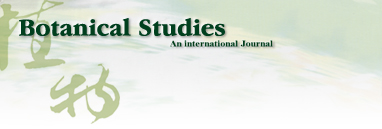| TITLE |
Identification of rice manganese-dependent protein kinases that phosphorylate sucrose synthase at multiple serine residues |
| AUTHOR |
Zheng-Chia Tsai
Department of Agricultural Chemistry, National Taiwan University, No. 1, Section 4, Roosevelt Road, Taipei, Taiwan 106
Ai-Yu Wang*
Department of Agricultural Chemistry, National Taiwan University, No. 1, Section 4, Roosevelt Road, Taipei, Taiwan 106 |
| FULL TEXT |
[in HTML format] [in PDF format]
|
| ABSTRACT |
Sucrose synthase from the etiolated seedlings of rice (Oryza sativa L. cv. Tainung 67) was phosphorylated both in vivo and in vitro. Four protein kinases that phosphorylated recombinant rice sucrose synthase 1 (RSuS1) in a Mn2+-dependent manner were partially purified and characterized from etiolated rice seedlings. These four kinases, designated as RPK1, RPK2, RPK3 and RPK4, are monomeric enzymes with apparent molecular masses of 34 kDa, 57 kDa, 30 kDa, and 30 kDa, respectively. Phosphoamino acid analysis of the 32P-labeled phosphorylated recombinant RSuS1 indicated that it was phosphorylated at serine residues by these four RPKs. RP-HPLC/ESI-MS analysis of the tryptic peptides of phosphorylated RSuS suggested that the serine residues in the tryptic peptides 13-LHSVR-17 and 168-HLSSK-172 were the target residues for phosphorylation. For confirmation of this finding, mutant recombinant RSuS1, S15A, S170A and S15A/S170A, were purified and subjected to phosphorylation by the four partially purified kinases. The results showed that both Ser15 and Ser170 residues were target residues for RPK1, PRK2 and PRK3 and Ser15 was the major phosphorylation site in RSuS1. Phosphorylation of RSuS1 may not occur exclusively at these two sites since weak phosphorylation of the double mutant protein S15A/S170A was also observed. Phosphorylation of the mutant S15A and S15A/S170A by RPK4 was undetectable, indicating that Ser15 was the only target residue for this kinase. |
| KEYWORD |
Manganese-dependent protein kinases; Rice; Sucrose synthase; |
| ARTICLE INFO |
Botanical Bulletin of Academia Sinica, Volume 44 Number 2 April 2003, page 141-150, 10 pages |
| PUBLISHER |
Institute of Plant and Microbial Biology, Academia Sinica, Taipei, Taiwan, Republic of China |

